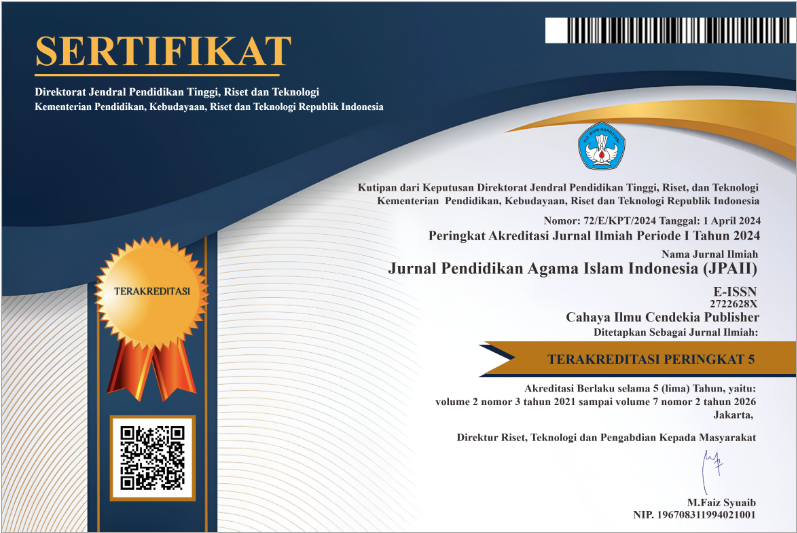Description of Student Communication and Attention Patterns In Islamic Religious Education Learning
Abstract
Purpose of the study: The purpose of this research is to describe the pattern of communication and the attention of students in learning Islamic religious education.
Methodology: The type of research used is quantitative research, the population in this study is students of Senior High School, the sample to be used in this study is determined by purposive sampling method, the instrument used is questionnaire and the data analysis techique is using statistic descriptive
Main Findings: The results of this study are that student communication is more dominant, good and also the attention of students is also very good in the process of learning the Islamic religion
Novelty/Originality of this study: The novelty of this research is to describe the communication skills and attention of students in the learning process of Islamic religion. Suggestions for further research are to find a link between communication skills and students' attention in the learning process so that it becomes even better.
References
F. I. Putri, F. Masda, M. Maison, and D. A. Kurniawan, “Analisis Hubungan Karakter Rasa Ingin Tahu Siswa Terhadap Minat Belajar Fisika di SMAN 11 Kota Jambi,” J. Phi J. Pendidik. Fis. dan Fis. Terap., vol. 3, no. 2, p. 19, 2022, doi: 10.22373/p-jpft.v3i2.13226.
I. Onyeator and N. Okpara, “Human Communication in a Digital Age: Perspectives on Interpersonal Communication in the Family,” New Media Mass Commun., vol. 78, no. 1, pp. 35–45, 2019, doi: 10.7176/nmmc/78-06.
D. Darmaji, A. Astalini, D. A. Kurniawan, F. I. Putri, R. Perdana, and F. Fuldiaratman, “Student’s need analysis in using ordinary differential equation e-module of Mathematical Physics II,” Momentum Phys. Educ. J., vol. 7, no. 1, pp. 107–115, 2023, doi: 10.21067/mpej.v7i1.7092.
A. F. Aziz, F. I. Putri, and M.Yudis, “Perbandingan Minat Belajat IPA Fisika Siswa pada Dua Kelas di Pondok Pesantren,” Didakt. J. Kependidikan, vol. 15, no. 1, pp. 26–37, 2021.
I. R. Gafurov, M. R. Safiullin, E. M. Akhmetshin, A. R. Gapsalamov, and V. L. Vasilev, “Change of the higher education paradigm in the context of digital transformation: From resource management to access control,” Int. J. High. Educ., vol. 9, no. 3, pp. 71–85, 2020, doi: 10.5430/ijhe.v9n3p71.
C. Z. Li et al., “Research trend of the application of information technologies in construction and demolition waste management,” J. Clean. Prod., vol. 263, 2020, doi: 10.1016/j.jclepro.2020.121458.
F. I. Putri, “Perbandingan Hasil Belajar Siswi Kelas VII C Dan VII D terhadap Mata Pelajaran IPA Fisika,” Qalam J. Ilmu Kependidikan, vol. 10, no. 1, pp. 38–47, 2021, doi: 10.33506/jq.v.
E. Goh and M. Sigala, “Integrating Information & Communication Technologies (ICT) into classroom instruction: teaching tips for hospitality educators from a diffusion of innovation approach,” J. Teach. Travel Tour., vol. 20, no. 2, pp. 156–165, 2020, doi: 10.1080/15313220.2020.1740636.
Y. Sudargini and A. Purwanto, “the Effect of Teachers Pedagogic Competency on the Learning Outcomes of Students,” J. Ind. Eng. Manag. Res. ( Jiemar), vol. 1, no. 4, pp. 2722–8878, 2020, doi: 10.7777/jiemar.
J. C. Richards, “Exploring Emotions in Language Teaching,” RELC J., vol. 53, no. 1, pp. 225–239, 2022, doi: 10.1177/0033688220927531.
H. Maulida and R. Y. Prawira, “Pola Komunikasi Siswa di Lingkungan Sekolah Ramah Anak,” Media Bina Ilm., vol. 14, no. 12, pp. 3717–3728, 2020, [Online]. Available: http://jurnal.umt.ac.id/index.php/nyimak.
H. Mohajan, Munich Personal RePEc Archive Quantitative Research: A Successful Investigation in Natural and Social Sciences, vol. 9, no. 4. 2020.
Y. Ramalisa, S. E. Septi, and F. I. Putri, “Comparison of Two Learning Models on Students ’ Process Skills in Elementary School,” vol. 6, no. 3, pp. 446–457, 2022.
M. Mulyati, F. I. Putri, and D. Deswalman, “Efforts to Improve Student Activities and Outcomes in Physics Learning Using the Two Stay Two Stray Technical Cooperative Learning Model at Senior High School,” Integr. Sci. Educ. J., vol. 4, no. 1, pp. 30–35, 2023, doi: 10.37251/isej.v4i1.294.
Copyright (c) 2023 Rismawan, Arnold Yasin Mol, Aliyu Ibrahim Musaddad

This work is licensed under a Creative Commons Attribution-NonCommercial 4.0 International License.
Authors who publish with this journal agree to the following terms:
- Authors retain copyright and acknowledge that the Jurnal Pendidikan Agama Islam Indonesia (JPAII) is the first publisher licensed under a Creative Commons Attribution 4.0 International License.
- Authors are able to enter into separate, additional contractual arrangements for the non-exclusive distribution of the journal's published version of the work (e.g., post it to an institutional repository or publish it in a book), with an acknowledgment of its initial publication in this journal.
- Authors are permitted and encouraged to post their work online (e.g., in institutional repositories or on their website) prior to and during the submission process, as it can lead to productive exchanges and earlier and greater citation of published work.






.png)
.png)





















